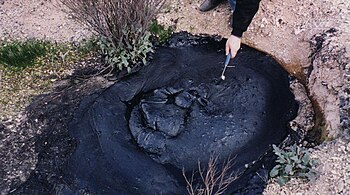



A petroleum seep is a place where natural liquid or gaseous hydrocarbons escape to the Earth's atmosphere and surface, normally under low pressure or flow. Seeps generally occur above either terrestrial or offshore petroleum accumulation structures.[1][failed verification] The hydrocarbons may escape along geological layers, or across them through fractures and fissures in the rock, or directly from an outcrop of oil-bearing rock.
Petroleum seeps are quite common in many areas of the world, and have been exploited by mankind since paleolithic times. A comprehensive compendium of seeps around the world was published in 2022.[2] Natural products associated with seeps include bitumen, pitch, asphalt and tar. In locations where seeps of natural gas are sufficiently large, natural "eternal flames" often persist. The occurrence of surface petroleum was often included in location names that developed; these locations are also associated with early oil and gas exploitation as well as scientific and technological developments, which have grown into the petroleum industry.
- ^ "Scientists Find That Tons Of Oil Seep Into The Gulf Of Mexico Each Year". ScienceDaily. January 27, 2000. Retrieved April 3, 2015.
- ^ Hryniewicz, Krzysztof (2022). "Ancient Hydrocarbon Seeps". In Kaim, Andrzej; Landman, Neil; Cochran, J. Kirk (eds.). Ancient Hydrocarbon Seeps of the World. Cham, Switzerland: Springer. pp. 571–648. ISBN 978-3-031-05621-5.